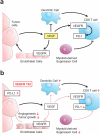Strategies to overcome therapeutic resistance in renal cell carcinoma
- PMID: 28089416
- PMCID: PMC5318278
- DOI: 10.1016/j.urolonc.2016.12.002
Strategies to overcome therapeutic resistance in renal cell carcinoma
Abstract
Background: Renal cell cancer (RCC) is a prevalent and lethal disease. At time of diagnosis, most patients present with localized disease. For these patients, the standard of care includes nephrectomy with close monitoring thereafter. While many patients will be cured, 5-year recurrence rates range from 30% to 60%. Furthermore, nearly one-third of patients present with metastatic disease at time of diagnosis. Metastatic disease is rarely curable and typically lethal. Cytotoxic chemotherapy and radiation alone are incapable of controlling the disease. Extensive effort was expended in the development of cytokine therapies but response rates remain low. Newer agents targeting angiogenesis and mTOR signaling emerged in the 2000s and revolutionized patient care. While these agents improve progression free survival, the development of resistance is nearly universal. A new era of immunotherapy is now emerging, led by the checkpoint inhibitors. However, therapeutic resistance remains a complex issue that is likely to persist.
Methods and purpose: In this review, we systematically evaluate preclinical research and clinical trials that address resistance to the primary RCC therapies, including anti-angiogenesis agents, mTOR inhibitors, and immunotherapies. As clear cell RCC is the most common adult kidney cancer and has been the focus of most studies, it will be the focus of this review.
Keywords: Angiogenesis; Immunotherapy; Renal cell carcinoma; Resistance; mTOR.
Copyright © 2017 Elsevier Inc. All rights reserved.
Figures



References
-
- Hanahan D, Weinberg RA. Hallmarks of cancer: the next generation. Cell. 2011;144:646–674. doi:10.1016/j.cell.2011.02.013. - PubMed
-
- Folkman J. Tumor angiogenesis: therapeutic implications. The New England journal of medicine. 1971;285:1182–1186. doi:10.1056/nejm197111182852108. - PubMed
-
- Kaelin WG., Jr The von Hippel-Lindau tumour suppressor protein: O2 sensing and cancer. Nat Rev Cancer. 2008;8:865–873. - PubMed
-
- Motzer RJ, et al. Sunitinib versus interferon alfa in metastatic renal-cell carcinoma. The New England journal of medicine. 2007;356:115–124. - PubMed
Publication types
MeSH terms
Substances
Grants and funding
LinkOut - more resources
Full Text Sources
Other Literature Sources
Medical
Research Materials
Miscellaneous

